Final results
| Category | Winners | Runners-up | Score |
|---|---|---|---|
| Men's singles | | | 21–17, 21–11 |
| Women's singles | | | 21–19, 17–21, 21–15 |
| Men's doubles | | | 21–17, 15–21, 21–13 |
| Women's doubles | | | 21–19, 15–21, 21–18 |
| Mixed doubles | | | 14–21, 21–15, 21–19 |
| Tournament details | |
|---|---|
| Total prize money | US$200,000 |
| Venue | Tokyo Metropolitan Gymnasium |
| Location | Tokyo, Japan |
The 2008 Japan Super Series is the seventh tournament of the 2008 BWF Super Series in badminton. It was held in Tokyo, Japan, from September 16 to September 21, 2008.
| Category | Winners | Runners-up | Score |
|---|---|---|---|
| Men's singles | | | 21–17, 21–11 |
| Women's singles | | | 21–19, 17–21, 21–15 |
| Men's doubles | | | 21–17, 15–21, 21–13 |
| Women's doubles | | | 21–19, 15–21, 21–18 |
| Mixed doubles | | | 14–21, 21–15, 21–19 |
| Previous Super Series: 2008 Indonesia Super Series | BWF Super Series, 2008 season | Next Super Series: 2008 China Masters Super Series |

Shigeru Miyamoto is a Japanese video game designer, producer and game director at Nintendo, where he serves as one of its representative directors as an executive since 2002. Widely regarded as one of the most accomplished and influential designers in video games, he is the creator of some of the most acclaimed and best-selling game franchises of all time, including Mario,The Legend of Zelda, Donkey Kong, Star Fox and Pikmin. More than 1 billion copies of games featuring franchises created by Miyamoto have been sold.
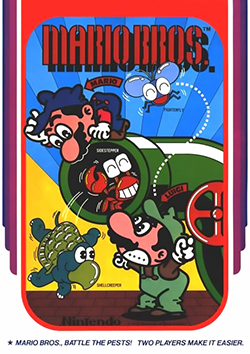
Mario Bros. is a 1983 platform game developed and published by Nintendo for arcades. It was designed by Shigeru Miyamoto and Gunpei Yokoi, Nintendo's chief engineer. Italian twin brother plumbers Mario and Luigi exterminate creatures, like turtles (Shellcreepers) and crabs emerging from the sewers by knocking them upside-down and kicking them away. The Famicom/Nintendo Entertainment System version is the first game to be developed by Intelligent Systems. It is part of the Mario franchise, but originally began as a spin-off from the Donkey Kong series.

Mario is a character created by the Japanese game designer Shigeru Miyamoto. He is the star of the Mario franchise, a recurring character in the Donkey Kong franchise, and the mascot of the Japanese video game company Nintendo. Mario is an Italian plumber who lives in the Mushroom Kingdom with his younger twin brother, Luigi. Their adventures generally involve rescuing Princess Peach from the villain Bowser while using power-ups that give them different abilities. Mario's distinctive characteristics include his large nose and mustache, overalls, red cap, and high-pitched, exaggerated Italian accent.
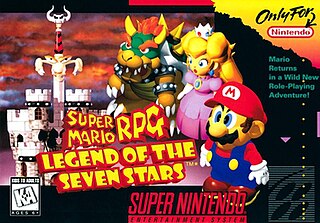
Super Mario RPG: Legend of the Seven Stars is a 1996 role-playing video game developed by Square and published by Nintendo for the Super Nintendo Entertainment System (SNES). It was the final Mario game for the SNES. The game was directed by Chihiro Fujioka and Yoshihiko Maekawa, produced by Shigeru Miyamoto, and scored by Yoko Shimomura.
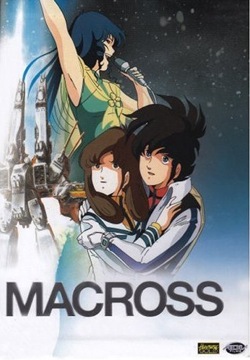
Super Dimension Fortress Macross is an anime television series from 1982. According to story creator Shoji Kawamori, it depicts "a love triangle against the backdrop of great battles" during the first Human-alien war. It is the first part of: The Super Dimension trilogy and the Macross franchise.
Power Rangers is an entertainment and merchandising franchise created by Haim Saban, Shuki Levy and Shotaro Ishinomori and built around a live-action superhero television series, based on Japanese tokusatsu franchise Super Sentai and currently owned by American toy and entertainment company Hasbro through a dedicated subsidiary, SCG Power Rangers LLC. It was first produced in 1993 by Saban Entertainment, which Saban sold to the Walt Disney Company and then brought back under his now-defunct successor company Saban Brands within his current company, Saban Capital Group, the Power Rangers television series takes much of its footage from the Super Sentai television series produced by Toei Company. The first Power Rangers entry, Mighty Morphin Power Rangers, debuted on August 28, 1993, and helped launch the Fox Kids programming block of the 1990s, during which it catapulted into popular culture along with a line of action figures and other toys by Bandai. By 2001, the media franchise had generated over $6 billion in toy sales.

Dragon Ball GT is a Japanese anime television series based on Akira Toriyama's Dragon Ball manga that ran from February 1996 to November 1997. Produced by Toei Animation, the series premiered in Japan on Fuji TV and ran for 64 episodes. Unlike Dragon Ball and Dragon Ball Z, the previous two television adaptations in the Dragon Ball media franchise, Dragon Ball GT does not adapt the manga by Toriyama. Dragon Ball GT is an anime-exclusive alternate sequel to Dragon Ball Z with an original storyline using the same characters and universe, which follows the exploits of Son Goku, the series protagonist who is turned into a child; his granddaughter, Pan; and their associates on a quest to collect the Black Star Dragon Balls, a more powerful set of Dragon Balls which are hidden throughout the galaxy.

Son Goku is a fictional character and the main protagonist of the Dragon Ball manga series created by Akira Toriyama. He is based on Sun Wukong, a main character of the classic 16th-century Chinese novel Journey to the West, combined with influences from the Hong Kong action cinema of Jackie Chan and Bruce Lee. Goku made his debut in the first Dragon Ball chapter, Bulma and Son Goku, originally published in Japan's Weekly Shōnen Jump magazine on December 3, 1984. Goku is introduced as an eccentric, monkey-tailed boy who practices martial arts and possesses superhuman strength. He meets Bulma and joins her on a journey to find the seven wish-granting Dragon Balls. Along the way, he finds new friends who follow him on his journey to become stronger. As Goku grows up, he becomes the Earth's mightiest warrior and battles a wide variety of villains with the help of his friends and family, while also gaining new allies in the process.

Okayama International Circuit (岡山国際サーキット), formerly known as TI Circuit Aida (TIサーキット英田) before 2005, is a 3.703 km (2.301 mi) private motorsport race track in Mimasaka, Okayama Prefecture, Japan. TI was the abbreviation of "Tanaka International" after the name of the golf club owner, Hajime Tanaka, though the name of the circuit was officially "TI Circuit Aida".
Super Smash Bros. is a crossover platform fighting game series published by Nintendo. The series was created by Masahiro Sakurai, who has directed every game in the series. The series is known for its unique gameplay objective which differs from that of traditional fighters, in that the aim is to increase damage counters and knock opponents off the stage instead of depleting life bars.

The Kamen Rider Series, also known as Masked Rider Series, is a Japanese superhero media franchise consisting of tokusatsu television programs, films, manga, and anime, created by manga artist Shotaro Ishinomori. Kamen Rider media usually revolves around the titular defined group of motorcycle-riding superheroes with an insect motif who fights supervillains, often known as kaijin.
Dragon Ball is a Japanese media franchise created by Akira Toriyama in 1984. The initial manga, written and illustrated by Toriyama, was serialized in Weekly Shōnen Jump from 1984 to 1995, with the 519 individual chapters collected in 42 tankōbon volumes by its publisher Shueisha. Dragon Ball was originally inspired by the classical 16th-century Chinese novel Journey to the West, combined with elements of Hong Kong martial arts films. Dragon Ball characters also use a variety of East Asian martial arts styles, including karate and Wing Chun. The series follows the adventures of protagonist Son Goku from his childhood through adulthood as he trains in martial arts. He spends his childhood far from civilization until he meets a teen girl named Bulma, who encourages him to join her quest in exploring the world in search of the seven orbs known as the Dragon Balls, which summon a wish-granting dragon when gathered. Along his journey, Goku makes several other friends, becomes a family man, discovers his alien heritage, and battles a wide variety of villains, many of whom also seek the Dragon Balls.

Super Smash Bros. Melee is a 2001 crossover fighting video game developed by HAL Laboratory and published by Nintendo for the GameCube. It is the second installment in the Super Smash Bros. series. It features characters from Nintendo video game franchises such as Mario, The Legend of Zelda, Star Fox, Pokémon, and Donkey Kong among others. The stages and gameplay modes reference or take designs from these franchises as well.
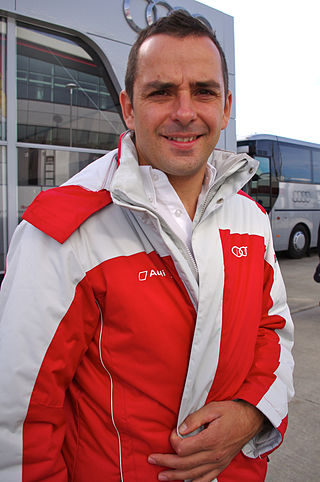
Benoît Tréluyer is a French professional racing driver.

Goombas, known in Japan as Kuribō, and originally Little Goomba, are a fictional species from Nintendo's Mario franchise. They first appeared in the NES video game Super Mario Bros. as the first enemy players encounter, part of Bowser's Army. They have appeared outside video games, including in film and television. They are brown mushroom-like creatures with long black eyebrows, a sharp underbite, a tan stem, dark brown feet, no limbs, and are most commonly seen walking around aimlessly, often as an obstacle, in video games. They were included late in the development of Super Mario Bros. as a simple, easy-to-defeat enemy.

Mario is a multimedia franchise created by game designer Shigeru Miyamoto for the Japanese video game company Nintendo, which produces and publishes its installments. Starring the titular Italian plumber Mario, it is primarily a video game franchise but has extended to other forms of media, including television series, comic books, a 1993 feature film, a 2023 animated film, and theme park attractions. The series' first installment was 1983's Mario Bros. even though Mario made his first appearance in 1981's arcade game Donkey Kong and had already been featured in several games of the Donkey Kong and Game & Watch series. The Mario games have been developed by a wide variety of developers. Mario games have been released almost exclusively for Nintendo's various video game consoles and handhelds, from the third generation onward.
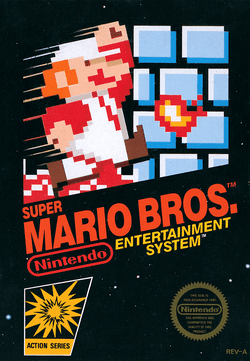
Super Mario Bros. is a 1985 platform game developed and published by Nintendo for the Nintendo Entertainment System (NES). It is the successor to the 1983 arcade game Mario Bros. and the first game in the Super Mario series. It was originally released in September 1985 in Japan for the Family Computer; following a US test market release for the NES, it was converted to international arcades on the Nintendo VS. System in early 1986. The NES version received a wide release in North America that year and in PAL regions in 1987.